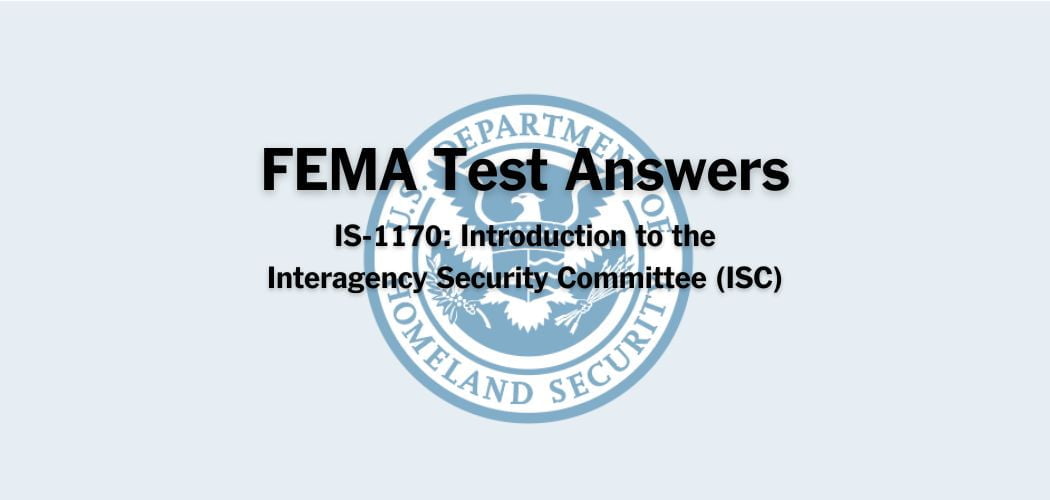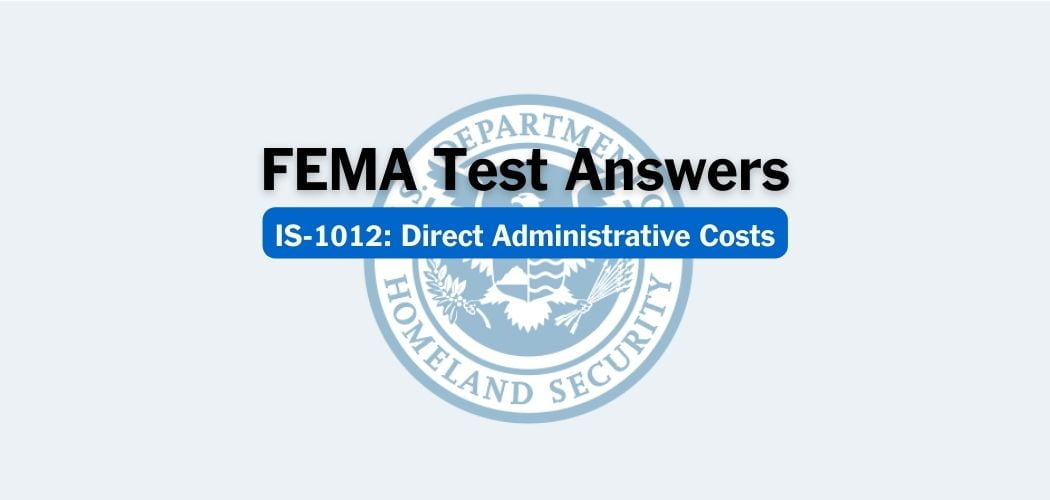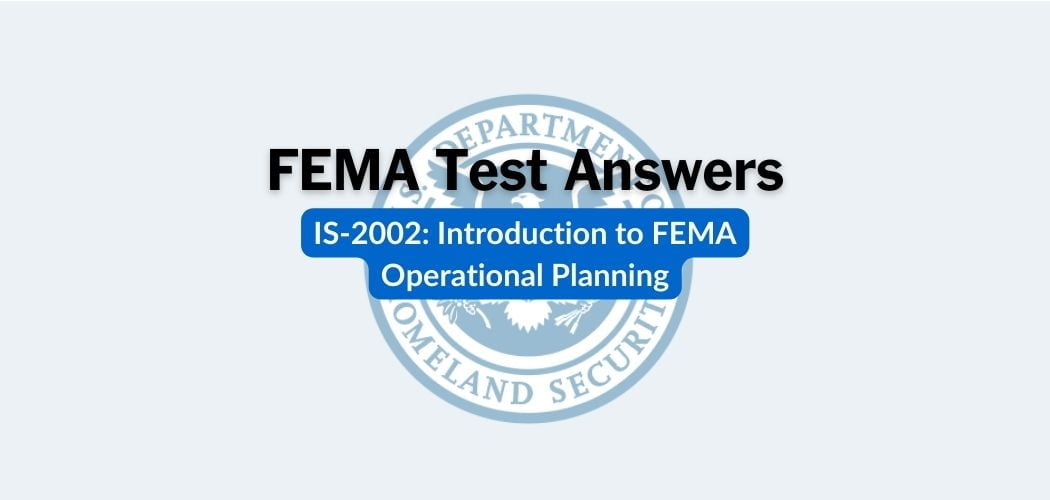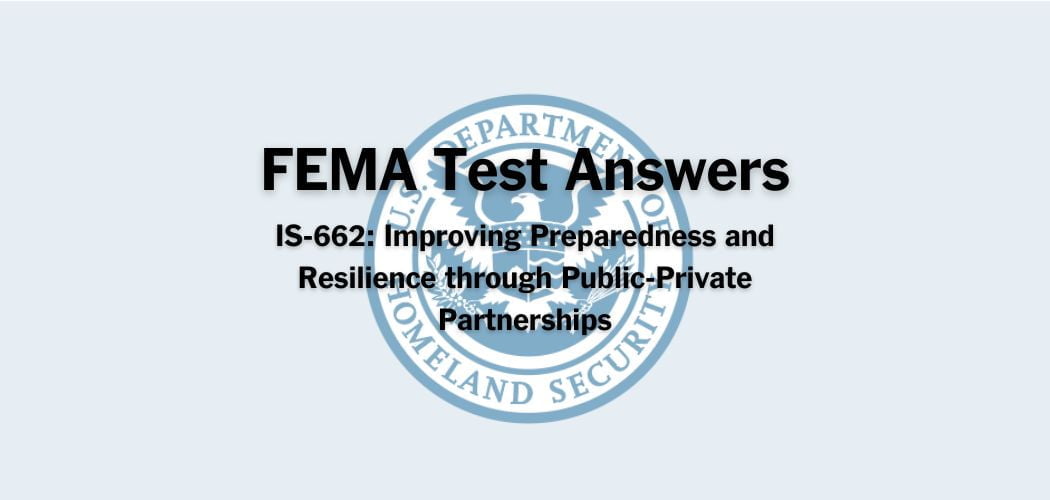Overview: The FEMA IS-1016 course was published on 2/28/2019 to provide an overview of environmental and historic preservation considerations that may affect Public Assistance projects.
By the end of the IS-1016 course, State, Local, Tribal, and Territorial Applicants and Recipients will have a general understanding of environmental and historic preservation compliance.
FEMA IS-1016 test answers
Each time this test is loaded, you will receive a unique set of questions and answers. The test questions are scrambled to protect the integrity of the exam.
Question 1. Compliance with the National Environmental Policy Act requires FEMA to do the following for every project:
A. Destroy all information about environmental resources that may negatively impact Public Assistance funded projects
B. Help Applicants with each Damage Inventory required throughout the Public Assistance grant life cycle
C. Collect information about the environmental resources that may be present in the area where the action will take place✅
D. Keep project information locked securely in Grants Portal so that Applicant information is protected
Question 2. Environmental and historic preservation concerns should be considered during projects involving all of the following conditions except:
A. Work with a new contractor✅
B. Debris operations
C. Ground disturbance
D. Work in water
Question 3. Failure to comply with processes and procedures as outlined in applicable environmental and historic preservation laws may affect the project in what way?
A. Cause delays to funding or work✅
B. Cause the project to receive more positive publicity
C. Cause the project to be completed more quickly
D. Cause an influx of grant funding
Question 4. Which type of stakeholders will Applicants have to regularly coordinate with to ensure environmental and historic preservation standards compliance?
A. Local and Territorial
B. Local and Tribal✅
C. Tribal and Territorial
D. Recipient and Federal
Question 5. Failure to comply with processes and procedures as outlined in applicable environmental and historic preservation laws can result in: A. Accelerated project schedule
B. Increased funding
C. Loss of funding✅
D. Positive publicity
Question 6. What important information is identified on the Greensheet?
A. Local and Tribal stakeholders for all disasters in the U.S.
B. Local and Tribal stakeholders relevant to the specific disaster✅
C. Federal and Recipient stakeholders relevant to the specific disaster
D. Federal and Recipient stakeholders for all disasters in the U.S.
Question 7. One of the primary goals of the National Environmental Policy Act is to:
A. Obligate Federal agencies to consider the potential impacts of their actions to the human environment✅
B. Ensure that FEMA follows the environmental and historic preservation review process
C. Determine the least expensive way for Federal agencies to carry out all Federal plans and projects
D. Ensure that all Federal agency projects do not negatively impact known historical sites and structures
Question 8. If an Applicant does not comply with environmental and historic preservation regulations, they may receive:
A. An accelerated project schedule
B. An increase in grant funding
C. Increased positive publicity
D. Fines and criminal or civil penalties✅
Question 9. At times, FEMA may decide that other values such as _________ outweigh the environmental impacts of a project.
A. socio-economic concerns, cost-effectiveness, or length of time to complete a project
B. socio-economic concerns, cost-effectiveness, or technical feasibility✅
C. socio-economic concerns, staffing concerns, or technical feasibility
D. staffing concerns, cost-effectiveness, or technical feasibility
Question 10. The primary historic preservation law for the nation is:
A. The Historic Advisory Council
B. The Federal Historic Preservation Law
C. The National Historic Preservation Act✅
D. The National Register of Historic Places
Question 11. How does FEMA use field engagement to ensure compliance with all applicable environmental and historic preservation laws, statutes, regulations, policies, and Executive Orders?
A. By defining the action and ensuring that project information is available to the public
B. By determining and evaluating the effects of the proposed action and alternatives
C. Through analysis of responses to Special Considerations questions
D. Through meetings, site visits, and consultations with stakeholders✅
Question 12. To comply with the National Environmental Policy Act, Applicants and Recipients must follow a specific decision-making process and documentation protocol during what time during the grant life cycle?
A. Throughout the project lifecycle✅
B. Before the grant money is dispensed
C. After the grant money has been dispensed
D. During the first phase of the grant process
Question 13. All of the following are true statements about the Environmental Assessment except:
A. It offers a concise analysis of Federal actions when the environmental impacts are uncertain
B. It is typically required by FEMA actions that involve significant modifications or new construction
C. It is the highest level of National Environmental Policy Act review and rarely required by FEMA actions✅
D. It is the second highest level of the National Environmental Policy Act review
Question 14. Recipients and Applicants of Public Assistance funding should initiate the environmental and historic preservation review process at what point in the project life cycle?
A. At grant closeout
B. From the start of any project✅
C. After the site inspection
D. When eligibility is approved
Question 15. What is the purpose of a Greensheet?
A. To explain what the Applicant must do to ensure that all Federal and State environmental and historic preservation requirements are met✅
B. To create new environmental and historic preservation compliance laws and regulations based on the specific site of the disaster
C. To determine if the Applicant’s first site inspection followed the environmental and historic preservation compliance requirements
D. To provide a complete and thorough environmental and historic preservation assessment of all Public Assistance funded projects
Question 16. FEMA’s environmental and historic preservation review covers compliance with which law?
A. Federal Historic Preservation Act
B. Environmental and Historic Executive Order
C. Local Environmental Preservation Regulation
D. National Environmental Policy Act✅
Question 17. What is a key resource an Applicant can use, along with coordinating with the FEMA Public Assistance Program Delivery Manager, to engage FEMA Environmental and Historic Preservation staff support?
A. A Greensheet
B. A Determination Memorandum✅
C. A Damage Inventory
D. A site inspection
Question 18. When is a Greensheet published by FEMA?
A. After applying for Public Assistance
B. Upon declaration of a disaster✅
C. After the site inspection
D. After grant funds have been issued



